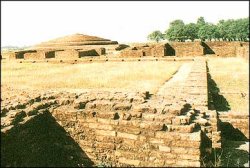KAPILAVATTHU

Kapilavatthu was the main town of the Sakyan clan and the place where Siddhattha Gotama spent most of his life prior to becoming a wandering ascetic. The Buddha said that when he was young he had three palaces there Ý one for the summer, one for the rainy season, and one for the winter, each with a pool of water lilies and lotuses of different colours (A.I,145). The town was described as being `rich, prosperous, full of people, crowded and thickly populated' (S.V,369) even though it is only ever referred to as a village (gàma, Sn.683). It had a council hall (santhàgara sàla) where the Sakyans elders would meet to discuss business (D.I,91). On one of his periodic visits to Kapilavatthu the Buddha was asked to inaugurate its new council hall. We are informed that carpets were laid in the hall, a water pot was put out and lamps were hung in preparation for this, and the Buddha sat beside the central pillar (M.I,353-4).
Later legend says Kapilavatthu was a magnificent city, whereas it was more likely to have been a small settlement built around the ruler's manor house. After the disappearance of Buddhism in India, Kapilavatthu was overgrown by jungle and only identified with certainty in 1973. Archaeological excavations revealed a ståpa first built shortly after the Buddha's passing away and remains from later times.
One often reads that Prince Siddhattha was `born and brought up in the foothills of the Himalayas' but this is not correct. The scriptures say that the Sakya country was `flanked by the Himalayas,' not in their foothills (Sn.422). The terrain around Kapilavatthu and nearby Lumbinã where Siddhattha was born, is completely flat. The Himalayan foothills only begin about another 20 kilometers further north.